Maine Home Garden News — August 2014
- August Is the Month to . . .
- Native Perennials for Late Season Bee Gardens
- Cover Crops for the Home Gardener
- Tomatoes: Maine Foods for August
August Is the Month to . . .
By Tori Lee Jackson, Extension Educator, University of Maine Cooperative Extension
- Harvest, Harvest, Harvest! August is one of the most productive months in our gardens. Here are a few timely fact sheets to help you:
- Bulletin #2063, Growing Hardneck Garlic in Your Maine Garden
- Bulletin #2077, Growing Potatoes in the Home Garden
- Bulletin #2068, Growing Peaches in Maine
- Bulletin #2253, Growing Highbush Blueberries
- Savor those summer flavors year-round with safely preserved produce from your garden or a local farm. Check out these great titles from our Let’s Preserve series:
- Bulletin #4044, Let’s Preserve Pickles
- Bulletin #4085, Let’s Preserve Tomatoes
- Bulletin #4035, Let’s Preserve Apples
- Bulletin #4039, Let’s Preserve Jellies, Jams, Spreads
- Bulletin #4046, Let’s Preserve Snap Beans
- See the entire series!
- Get some hands-on experience with preservation at our workshops. Here is the 2014 schedule.
- Have more produce than you can use? Consider donating to Maine Harvest for Hunger! Bulletin #4303, A Donor’s Guide to Vegetable Harvest will tell you when to harvest for the best quality.
http://youtu.be/uV5LrSdkR5s
- Consider saving seeds for next year’s garden with Bulletin #2750, An Introduction to Seed Saving for the Home Gardener.
- Plant crops for fall harvest. Spinach, lettuce, kale, and other cole crops do well with shorter day lengths. Fill in your empty spots by direct seeding greens and transplanting broccoli, cauliflower, and cabbage now.
- Fix your lawn. Have some trouble spots or interested in reseeding your entire lawn? Mid-August through September is the best time of year to establish new grass. Check out Bulletin #2367, Establishing a Home Lawn in Maine, Bulletin #2243, Maintaining a Home Lawn in Maine, and Bulletin #2166, Steps to a Low-Input, Healthy Lawn for tips and step-by-step instructions.
- Research. If your new lawn or major landscaping project includes building a pond, be sure to read Bulletin #2374, Before You Build a Pond: 10 Important Questions and Answers before you start.
- Be on the lookout for pests in your yard and garden. From tomato hornworm to hemlock wooly adelgid, insects are enjoying this bountiful time of year as much as we are. Scout your garden and landscape regularly for any invaders and contact your local UMaine Extension county office with questions. Bulletin #2188 Pest Management for the Home Vegetable Garden in Maine is a great addition to your gardening library as well.
- Think Spring! Divide your existing lilies and irises, and order bulbs to plant for next year.
- Irrigate. August can be one of the driest months of the year. Keep your soil moist without over-watering or wasting water with Bulletin #2160, Trickle Irrigation: Using and Conserving Water in the Home Garden.
Native Perennials for Late Season Bee Gardens
By Dr. Lois Berg Stack, Extension Specialist, Ornamental Horticulture, University of Maine, lois.stack@maine.edu
In Maine, more than 250 species of bees work hard on our behalf. From early spring until hard frost in the fall, they gather nectar and pollen from flowers. In the process, they move pollen from one flower to another, enabling production of crops such as tomatoes, squashes, melons, blueberries, and apples. And of course, honey bees make the honey that we harvest for our own use.
Bee resources are in decline. Every year, we convert large amounts of land to roadways, parking lots, buildings, and other structures. Although we landscape most of these developed areas, we don’t always consider bees in our plant choices, and we almost never plant the same number of plants that we remove. In our development projects, we also reduce the number of sites where bees can nest: places like open soil, areas with native clump grasses, snag trees, and stands of hollow or pithy stems from the previous year’s plant growth; all of these places can provide nest sites for a variety of native bees.
As a gardener, there are several things you can do to support bees. You can eliminate or at least reduce insecticides in your landscape, and provide nest sites and shallow water resources. And, you can plant plants that provide food for bees.
Eight Great Native Perennials for Fall Bee Gardens
Most species of bees in our gardens are native. Why not plant native plants to support them? The following eight plants share these characteristics: they are native to Maine, they die back to the ground each fall, they support bees in late summer and fall by providing nectar and/or pollen, and they are becoming increasingly available at garden centers and nurseries.
Giant blue hyssop (Agastache foeniculum) is a Mint Family member that performs well in partial sun to full sun, and in moist to quite dry soils. It is a multi-stem plant that reaches 2-4 feet in height. Its small lavender/blue flowers develop in vertical clusters over a long season from June to September. These flowers attract honey bees, along with native bumble bees, leaf-cutter bees, and sweat bees. They also attract several flies, butterflies, skippers, and moths.
Bottle gentian (Gentiana andrewsii), a member of the Gentian Family, produces clusters of 1-inch long bottle-shaped blue flowers on top of 1-2 foot plants, in August and September. Plants are often sprawling, but their charming blue flowers make them favorites of many gardeners. Bottle gentian performs best in full or partial sun, and in moist soil. It does not do well in dry soils. Bumble bees visit this plant in good numbers, crawling down into the tubular flowers to feed.
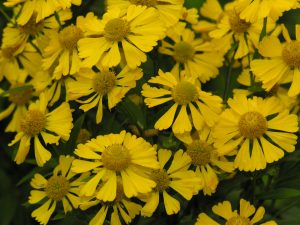
Helenium autumnale as a wildflower has the unfortunate common name Sneezeweed. However, it has long been cultivated in perennial gardens, where it is known as Helen’s flower. This 3-5 foot member of the Sunflower Family is one of the showiest plants of the fall garden. Its broad, airy clusters of half-inch yellow/mahogany/red daisy-type flowers are reminiscent of pinwheels. They flower for weeks in autumn, are great cut flowers, and attract honey bees, bumble bees, cuckoo bees, and leaf cutter bees. Helen’s flower performs best in full sun and moist soil. Many cultivated types have been introduced to the world of gardening, and some of them are more compact, making them an excellent choice for smaller gardens.
Everyone knows the common sunflower, but many other species of the genus Helianthus also deserve a place in the landscape. Giant sunflower (Helianthus giganteus) is a perennial plant that reaches 6-8 feet in height. Its major stem is unbranched, but a few smaller side stems usually develop as well. It’s a coarse-textured Aster Family plant for the moist meadow, as it can spread over time. Its yellow flowers develop in late summer, each 2-3 inches across, and are visited by both long-tongued bees like bumble bees, and short-tongued bees like miner bees.
Wild bergamot (Monarda fistulosa) is often overlooked as a garden plant, and is overshadowed by its close relative, Beebalm (Monarda didyma). Wild bergamot is a Mint Family member, 2.5-4 feet tall, well branched, and vigorous. In moist, full-sun conditions, it can spread quickly, so is useful in a meadow planting. If grown in a perennial border, it must be reined in each spring, as it spreads by shallow rhizomes. For about one month from midsummer to early fall, its lavender or pink flowers develop in 1-3 inch wide clusters at tips of stems. Each flower is tubular and about an inch long, making it a good plant for “long-tongued bees” such as bumble bees, miner bees, cuckoo bees, and larger species of leaf-cutting bees. Butterflies also feed on these flowers.
Slender mountain mint (Pycnanthemum tenuifolium) is a Mint Family member whose slender stems reach 1-3 feet in height. Its foliage produces a sweet minty smell when touched, and in late summer its stems are topped by small flat heads of ¼-inch white flowers. Slender mountain mint “walks” across the garden, spreading by underground stems. It is useful in a wild area or a meadow planting, in full sun and dry well-drained soil. Its nectar attracts a wide range of bees, along with many flies.
Wild senna (Senna hebecarpa) is a native Legume Family plant that deserves consideration for large perennial borders or meadows with full sun and moist soil. It reaches 5-6 feet in height, with a strong stem that supports fine-textured compound gray-green leaves. It’s a striking plant all summer, and in August and September it produces clusters of 1-inch yellow flowers that attract large numbers of bumblebees.
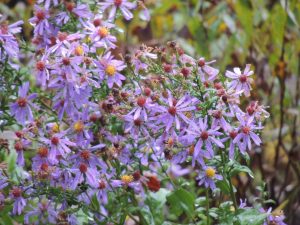
The asters dominate the fall garden. Three native Maine species are commonly found in full-sun, moist-soil natural areas, have been hybridized to produce a variety of cultivars, perform well in the garden, and are widely available in garden centers and nurseries. Their generic name has changed from Aster to Symphyotrichum, but you’ll likely still find them listed as Aster in plant lists. The first, Symphyotrichum novae-angliae, is New England Aster. Its hairy stems reach 4 feet in height and produce showy clusters of blue or purple flowers, each with 30 or more ray florets (the “petals” of many Aster Family flowers). New York Aster (Aster novi-belgii) is similar to New England aster, but its flowers generally have 15-25 ray florets. Hundreds of cultivars of this plant have been introduced to the gardening world, and are generally known as Michaelmas daisies. This species performs well in wetter soils. Smooth aster (Symphyotrichum laeve) is similar to the other two species, but has smooth (hairless) stems. Bumble bees, honey bees, leaf-cutter bees, and miner bees flock to asters every fall, producing a chorus of soft noise on warm fall afternoons.
Cover Crops for the Home Gardener
By Rick Kersbergen, Extension Educator, Waldo County, University of Maine Cooperative Extension, richard.kersbergen@maine.edu
As vegetables are harvested from your garden…perhaps the peas, or the first crop of broccoli, it is time to think about planting a cover crop that will take its place. August is the month to think about growing something to help your garden for the next season. A cover crop is grown for a variety of reasons…weed control, improving soil, protecting soil, growing your own nitrogen, etc. All these benefits can be accomplished by growing a cover crop, rather than leaving your soil bare or letting weeds take over!
It is important to realize that “nude” soil suffers from a variety of maladies. First, it is an opportunity for weeds to grow and proliferate, either by producing more seed or by spreading vegetatively. Bare soil also is prone to erosion in heavy rainfalls as well as increased leaching of valuable nutrients. Additionally, a bare soil is one that does not improve underground biological activity.
I also like to think of cover crops as solar collectors for our soil. The more biomass we can grow and add back to our soil, the more “Solar Gain” we can use to improve our garden for the future.
So what should you grow as cover crops in your garden? Much depends on what you are trying to accomplish from the goals listed above. Since it is almost August as I write this, I will focus on those crops that you might want to plant for winter cover—plants that will grow late into the season, scavenge nutrients, provide biomass, and protect the soil during the winter and spring to come.
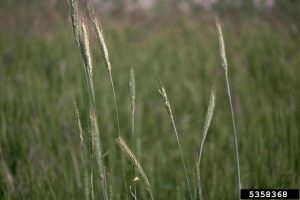
The traditional cover crop used for many years is cereal rye or often called winter rye. It is sown from now through late September, and produces a lot of great winter cover and scavenges some nitrogen left over from the garden season and holds it for next year. Winter rye survives the winter and grows aggressively next spring. While this is great for capturing solar radiation on both sides of the winter months, many gardeners find it difficult to kill in the spring since it can produce copious amounts of growth that are hard to deal with. Winter rye should be sown at 6-10 pounds per 1,000 sq. ft. (higher if later in the season). Broadcasting the seed and raking it in is effective, but if you have a lawn roller, you will get better germination if you lightly roll the seed after raking.
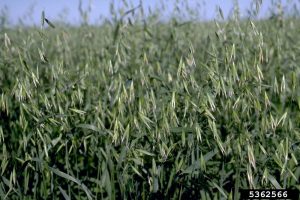
Oats are an alternative winter cover crop. Like winter rye, it grows aggressively in the fall, but winter kills, so you are left with a deal mat of material in the spring. This dead mat provides good cover and may also serve as a “mulch” for some early garden crops. I use oats because they are cheap. I buy a 50-pound bag of “whole oats” that is commonly fed to horses as my seed source and increase the seeding rate to get an effective cover. Oats can also be sown from now through September.
Annual Ryegrass is another fast growing winter cover that winter kills. It can be seeded immediately after crops are removed from the garden and should be sown before mid-September if possible to provide good cover. While usually reliable as a “winter killed” crop, there may be situations where annual ryegrass does survive and grow again in the spring. Annual rye is a fine seed, so seeding rates are much lower ~ 1 pound per 1,000 square feet if sown by broadcast and raked and rolled.
What about legumes? Legumes are often mixed with the above cover crops to help diversify the mix and also to “fix” nitrogen for next season. Some things to remember about the legumes you may want to add. It is important to inoculate the seed with the correct Rhizobia so you ensure nitrogen fixation. Some seeds come pre-inoculated, but more often you need to mix the inoculant with the seed yourself. Specific inoculant can be purchased online from seed companies or in garden centers.
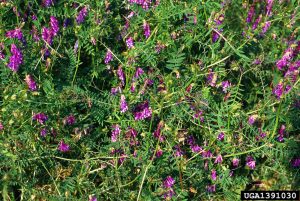
What legumes might you add to the mix? Hairy Vetch is one used by many commercial vegetable producers. It can survive the winter in some circumstances and may be an issue for you when you want to till it in the spring, as it grows with a vine-like manner that has rototillers screaming as it wraps around the tines! Another one that has gained some more popularity lately is Crimson Clover, as it is low growing and more often than not, will winter kill. Both these legumes can be added in small amounts to the cereal grains listed above ~ .05-1 pound/1,000 sq ft.
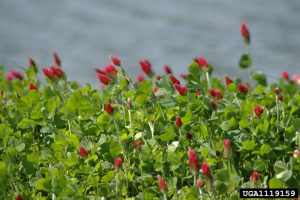
There are more cover crops options that we are seeing many growers start to use. Brassica crops (radish, mustards etc.) also grow well in the fall and provide a lot of biomass to protect the soil and scavenge nutrients. Often these are now mixed with traditional cover crops to make a cover crop cocktail!
Maine Farm Days on August 20-21 in Clinton Maine (Misty Meadows Farm) will feature a demonstration plot of a variety of cover crops. Make a plan to visit the farm and look at some of the individual crops as well as some of the cover crop cocktails!
Food and Nutrition
Tomatoes: Maine Foods for August
By Kathy Savoie, MS, RD, Extension Educator, Cumberland County, University of Maine Cooperative Extension, ksavoie@maine.edu
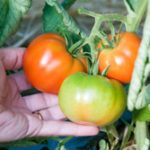 There is nothing like a Maine-grown tomato during summer! From mid-July to late September, Maine residents can enjoy the freshness and flavor of locally grown tomatoes picked at peak ripeness. Though technically a fruit, the tomato is treated as a vegetable. Originally tomatoes were yellow, but today most of those produced in the United States are red. In addition to the standard-sized, round tomatoes, there are other varieties, such as plum, pear-shaped, and cherry tomatoes.
There is nothing like a Maine-grown tomato during summer! From mid-July to late September, Maine residents can enjoy the freshness and flavor of locally grown tomatoes picked at peak ripeness. Though technically a fruit, the tomato is treated as a vegetable. Originally tomatoes were yellow, but today most of those produced in the United States are red. In addition to the standard-sized, round tomatoes, there are other varieties, such as plum, pear-shaped, and cherry tomatoes.
Tomatoes are rich in vitamins A and C and fiber, and are cholesterol free. Field- or vine-ripened tomatoes available in summer are higher in vitamin C than the greenhouse tomatoes that are available in fall and winter. Fresh tomatoes contain more vitamin C than cooked or canned. Tomatoes contain lycopene, an important carotenoid, which may help protect against prostate cancer and heart disease.
Using, Storing, and Preserving Tomatoes
Keep ripe tomatoes at room temperature; above 55 degrees is recommended. Do not refrigerate under-ripe fruit. Tomatoes will ripen better out of sunlight. Once tomatoes are red and slightly soft, they will keep a day or two at room temperature. Refrigerate only if you want to keep them longer. For recipes using fresh tomatoes, follow these links:
- Bulletin #4178, Vegetables and Fruits for Health: Tomatoes
- Choosing, Storing & Using Fresh Produce — Tomatoes
With tomato season upon us, it is important for home canners to know that to ensure the safety of whole, crushed or juiced tomatoes, additional acid is needed whether you process them in a boiling water bath or pressure canner. To acidify tomatoes, add 1 tablespoon of bottled lemon juice per pint of tomatoes or 2 tablespoons of lemon juice per quart of tomatoes. For more information, see Bulletin #4085, Let’s Preserve Tomatoes.
Freezing tomatoes is a simple and quick way to preserve them. View our video on freezing tomatoes.
If you are looking to amp up your intake of local foods, preserving is a skill to learn to help extend your access to local foods year round. Learn more about our hands-on food preservation workshops.
University of Maine Cooperative Extension’s Maine Home Garden News is designed to equip home gardeners with practical, timely information.
Let us know if you would like to be notified when new issues are posted. To receive e-mail notifications fill out our online form.
Contact Lois Elwell at lois.elwell@maine.edu or 1.800.287.1471 (in Maine).
Visit our Archives to see past issues.
Maine Home Garden Newswas created in response to a continued increase in requests for information on gardening and includes timely and seasonal tips, as well as research-based articles on all aspects of gardening. Articles are written by UMaine Extension specialists, educators, and horticulture professionals, as well as Master Gardener Volunteers from around Maine, with Professor Richard Brzozowski serving as editor.
Information in this publication is provided purely for educational purposes. No responsibility is assumed for any problems associated with the use of products or services mentioned. No endorsement of products or companies is intended, nor is criticism of unnamed products or companies implied.
© 2014
Call 800.287.0274 or TDD 800.287.8957 (in Maine), or 207.581.3188, for information on publications and program offerings from University of Maine Cooperative Extension, or visit extension.umaine.edu.
